This is an interesting reaction for three reasons related to selectivity and choice of reaction conditions.
PTC is used here to form a cyclic compound by reacting a diol with a bis(benzyl chloride) in the presence of a bisphenol. One would speculate that there would be competition between intermolecular etherification and intramolecular etherification to form oligomeric byproducts as well as the desired cyclic product. Phase-transfer catalysis is often used to simulate high dilution for these types of intramolecular versus intermolecular competitions (we teach this in our in-house PTC course), but in this case, the inventors use 2 moles of diol per mole of dichloride which would promote intermolecular side reaction. The inventors do not disclose the amount of solvent, selectivity or yield of the reaction, but they are apparently high enough to synthesize the desired product that is later functionalized with cobalt to produce a polymerization catalyst.
When a diol is not soluble in the organic reaction phase, PTC can be used to simulate high dilution by transferring only an amount of diol to the reaction phase equal to the molar catalyst loading (as we teach in our in-house PTC course), 4% in this case. If that is the case here, then the excess diol in the system would not translate into excess diol in the same phase with the dichloride which in turn would result in desired selectivity. However, the use of methylene chloride with this pyridinium salt might negate the leverage of this concept of immiscibility. The high ionic strength in the aqueous phase would further not provide an opportunity to dissolve the pyridinium salt in the aqueous phase. So, it is not clear why the inventors achieve good selectivity for cyclization versus oligomerization.
In addition, the inventors use a large excess of 50% NaOH (10 moles per mole of dichloride). In PTC systems, when there is competition between a phenoxide and an alkoxide for etherification, the phenoxide usually attacks the alkylating agent even though the alkoxide is more nucleophilic than the phenoxide (specific examples of this are taught in our in-house PTC course). The reason is that when you limit the amount of NaOH, the more acidic phenoxide is in a much higher concentration than the alkoxide due to the difference in pKa (by a factor of about 1 million) and the quaternary ammonium phase-transfer catalyst greatly prefers to associate with and transfer monoanions than dianions (or dianions instead of tetraanions in the case of the reaction shown above). The reason that the reaction shown in the diagram reacts at the alkoxide sites may be a combination of steric hindrance around the phenoxide (though PTC does a great job in activating sterically hindered phenoxides) and the fact that 10 moles of NaOH were used per mole of dichloride.
Yet another interesting aspect of this procedure is that PTC was used with methylene chloride as the solvent in the presence of NaOH. This often causes two problems. One is that PTC/OH/methylene chloride produces formaldehyde and that is something we usually want to avoid. A second problem is that methylene chloride can act as an alkylating agent itself and “methylene bridging” is often observed forming an acetal (specific examples of this are taught at our in-house PTC course).
We would have been very curious to learn of the yield and selectivity of this reaction. Even though they were not provided, this PTC reaction is interesting enough to warrant the discussion of several fine points to consider when developing PTC processes.
If your company needs to achieve the highest performance and lowest cost processes for challenging reactions or even routine strong base reactions, nucleophilic substitutions, oxidations or reductions, contact Marc Halpern of PTC Organics to integrate the unmatched highly specialized expertise in industrial phase-transfer catalysis with your process R&D needs.


